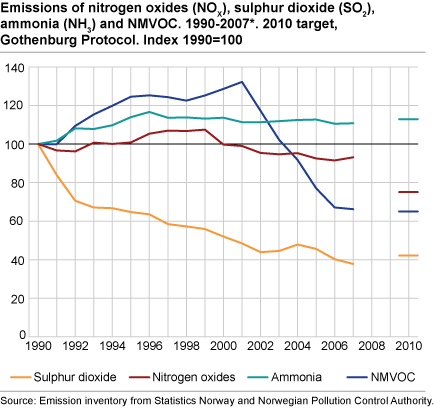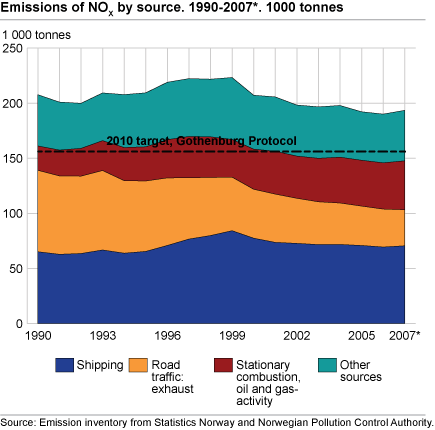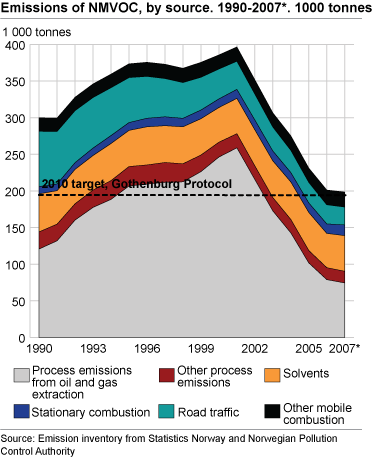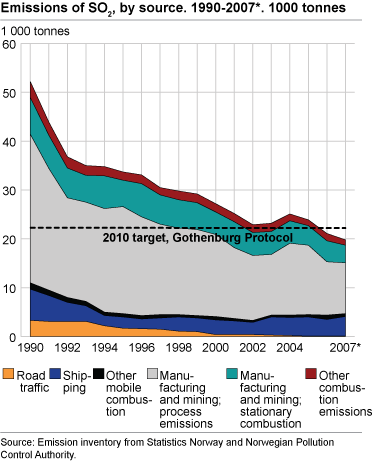Content
Published:
This is an archived release.
Increase in NOX emissions
Nitrogen oxides (NOX) emissions amounted to 193 500 tonnes in 2007. The emissions must be reduced by 19 per cent by 2010 to fulfil Norway’s international commitments. The NMVOC emissons amounted to 199 000 tonnes, barely 4 000 tonnes above the requirements of the Gothenburg Protocol.
These figures come from the Norwegian emission inventory, which is produced by Statistics Norway (SSB) in close collaboration with the Norwegian Pollution Control Authority (SFT). After the publication of preliminary emission figures for 2007 on the 13th of May 2008, more detailed energy data, and better data for some manufacturing companies have become available. Based on this new information, new calculations have been carried out.
| Component | Emissions 1990 | Emissions 2007* | Emission ceiling 2010 | Necessary reduction 2007-2010 | |||||||||||||||||||||||||||||||||||
|---|---|---|---|---|---|---|---|---|---|---|---|---|---|---|---|---|---|---|---|---|---|---|---|---|---|---|---|---|---|---|---|---|---|---|---|---|---|---|---|
| Nitrogen oxides (NOX) | 207 795 | 193 490 | 156 000 | 37 500 tonnes (19 per cent) | |||||||||||||||||||||||||||||||||||
| Sulphur dioxide (SO2) | 52 198 | 19 736 | 22 000 |
Emission ceiling appr.
reached at the moment |
|||||||||||||||||||||||||||||||||||
| NMVOC | 299 893 | 198 567 | 195 000 | 3 600 tonnes (1.8 per cent) | |||||||||||||||||||||||||||||||||||
| Ammonia (NH3) | 20 377 | 22 570 | 23 000 |
Emission ceiling appr.
reached at the moment |
|||||||||||||||||||||||||||||||||||
| Source: Emission inventory from Statistics Norway and Norwegian Pollution Control Authority. |
NOX emissions increasing in spite of aims at reduction
The Norwegian NOX emissions amounted to 193 000 tonnes in 2007, an increase of 2 per cent from 2006. An important source of the increased emissions was start-up problems at the LNG-installation (installation for receiving and processing of natural gas) on Melkøya outside Hammerfest, which resulted in flaring a lot of gas instead of utilizing it. The emissions must decrease with 19 per cent, or 37 500 tonnes, within 2010, to fulfil Norway’s emission targets at 156 000 tonnes given in the Gothenburg Protocol. The Government introduced in January 2007 a new NOX tax. For the time being we do not have enough information to conclude that this tax was sufficient to keep the emission trend negative. In January 2008, a NOX agreement was also signed between the Government and 14 trade associations.
The three dominating sources for NOX emissions are road traffic, domestic sea transport and fishing, and oil and gas activities, which together accounted for 76 per cent of the emissions in 2007. Emissions from road traffic have decreased 5 per cent since 2006. In 1989 strict NOX exhaust requirements was set for petrol vehicles and there has been a 56 per cent reduction for road traffic since 1990. The impact of the renewal of the car fleet is reduced however since many new cars are diesel cars. Emissions have decreased also for diesel cars after the first NOX emission requirements for heavy diesel vehicles were set in 1993, but new diesel cars still have higher NOX emissions than new petrol cars. In 2007 three of four sold passenger cars were diesel-powered.
Emissions from domestic sea transport and fishing have increased 1.5 per cent since 2006, and are now 8 per cent above the 1990 level. Domestic sea transport and fishing is the largest single emission source for NOX with 36 per cent of the total emissions, most of which (68 per cent) comes from coastal traffic.
Oil and gas activities accounted for 23 per cent of the NOX emissions in 2007. Emissions have increased with 6 per cent since 2006. Since 1990 the emissions are doubled and now amount to 44 000 tonnes.
Decrease in emissions of NMVOC
Emissions of NMVOC (non-methane volatile organic compounds) shall, according to the Gothenburg Protocol, be reduced to 195 000 tonnes in 2010. In 2007 these emissions amounted 199 000 tonnes. Since the peak year 2001, emissions have almost halved. Norway’s emissions are now almost 2 per cent above the target. The most important sources are the evaporation of hydrocarbons by loading and unloading of crude oil which contribute to 37 per cent, and emissions from solvents which contributed to about 24 per cent of the emissions in 2007. A decree from the Norwegian Pollution Control Authority that loading and unloading of crude oil on the continental shelf should be done by using technology that limits the NMVOC emissions, is the most important reason for the decrease in the total emissions since 2001.
The emissions of NMVOC from road traffic are also strongly reduced. This is due to exhaust gas restrictions and an increase in the number of diesel cars, which have much lower NMVOC emissions than petrol cars.
Because of a new calculation method, emissions of NMVOC from the use of solvents and other products have been corrected upwards since the previous publication of these figures, and this new method has resulted in the total emission figures for NMVOC now being above the commitment of the Gothenburg Protocol. Emissions from the use of solvents and other products in 2007 are calculated to be 4 410 tonnes higher with the new model than with the old method.
|
Recalculations According to international guidelines for reporting of emission data, the emissions shall be recalculated if new knowledge about emission factors or new improved methods of calculations are available, as for example that new sources are included in the Norwegian emission inventory. New calculations shall be made consistent for the whole time series. As a result of calculation improvements every year, Statistics Norway and the Norwegian Pollution Control Authority yearly publish new figures back to 1990. |
SO2 and ammonia below the emission targets
The emissions of sulphur dioxide (SO2) was in 2007 almost 20 000 tonnes and have continued a descending trend. For the second year the emissions are below the 2010 target of 22 000 tonnes in the Gothenburg Protocol.
Emissions of ammonia were almost 23 000 tonnes in 2007. The emissions had a weak increase between 2006 and 2007, but are still below the target for the year 2010 on 23 000 tonnes in the Gothenburg Protocol.
Other emission statistics published today
Emissions to air of heavy metals and persistent organic pollutants
Documentation of the emission accounts
Tables:
The statistics is published with Emissions to air.
Contact
-
Statistics Norway's Information Centre
E-mail: informasjon@ssb.no
tel.: (+47) 21 09 46 42





